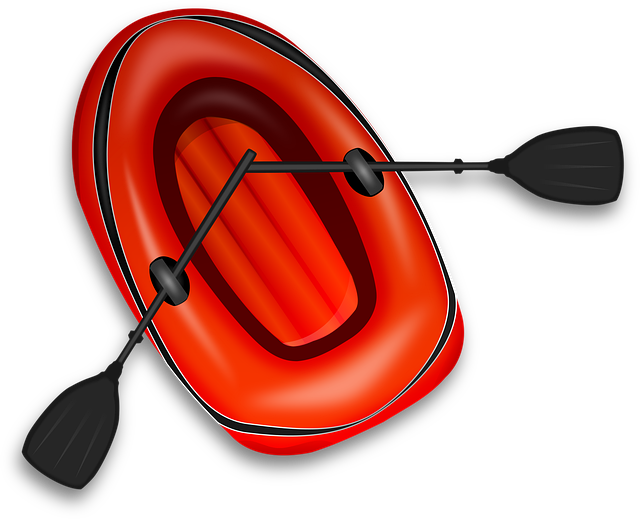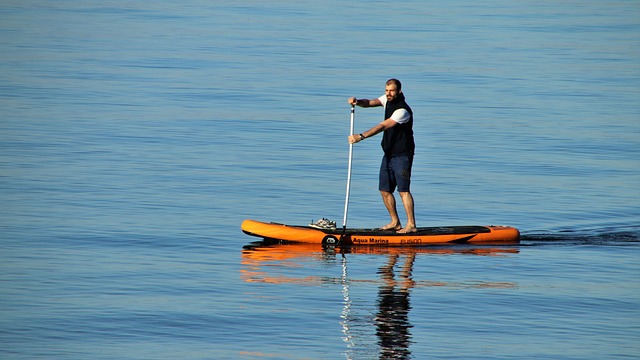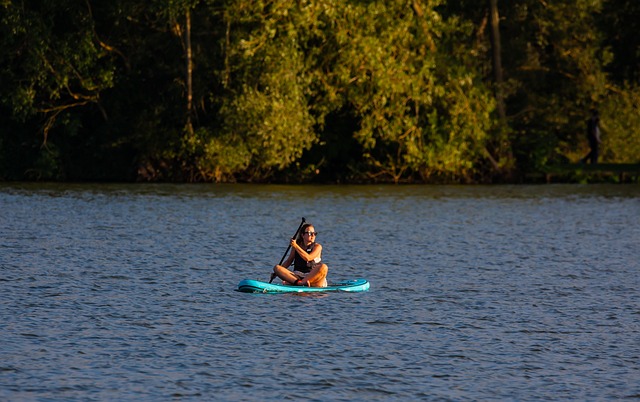Inflatable Paddle Boards (IPBs) have become a popular choice for recreation and fitness enthusiasts due to their portability, versatility, and accessibility. They cater to various skill levels with different designs, materials, and sizes. IPBs offer low-impact workouts targeting multiple muscle groups while improving balance and core strength. When choosing between stand-up and sit-down options, consider your fitness goals, comfort levels, and personal preferences. Both positions provide unique benefits for specific workouts, with proper posture crucial for optimal results and injury prevention. With the right exercises and safety considerations, IPBs enable users of all levels to enhance balance, strength, and overall fitness while enjoying outdoor water activities.
Looking to enhance your water workout routine? Inflatable paddle boards (IPBs) offer a versatile and accessible option, whether you prefer standing or sitting. This guide navigates the stand-up vs. sit-down debate, providing insights into the key differences, benefits, and ideal posture for various fitness goals. From ergonomic considerations to popular exercises and expert tips, we empower you to make an informed decision when choosing your IPB features.
Understanding Inflatable Paddle Boards: A Quick Overview

Inflatable paddle boards (IPBs) have gained immense popularity in recent years, offering both recreational and fitness enthusiasts a versatile water activity option. These boards are precisely what their name suggests—a paddle board that is inflated to create a rigid platform, allowing users to stand and maneuver on top of it while using a paddle to navigate through the water. IPBs come in various sizes, shapes, and materials, catering to different skill levels and preferences.
The appeal of inflatable paddle boards lies in their convenience and accessibility. They are easy to transport as they can be deflated, rolled up, and packed into compact bags, making them ideal for outdoor adventures, beach trips, or even urban exploration. Additionally, IPBs provide a low-impact workout, engaging multiple muscle groups while improving balance and core strength. Whether it’s a casual paddle on a calm lake or an intense workout in the ocean waves, inflatable paddle boards offer a unique and enjoyable way to connect with nature and stay active.
Stand-Up vs Sit-Down: Key Differences and Benefits

When choosing between a stand-up or sit-down option, especially for activities like using an inflatable paddle board, understanding the key differences and benefits is crucial. Stand-up options, as the name suggests, require you to maintain an upright position throughout your activity. This enhances core engagement, improves balance, and provides a full-body workout. It’s ideal for building strength in your legs, back, and arms, promoting stability and agility.
In contrast, sit-down alternatives offer a more relaxed posture, reducing the workload on specific muscle groups. These options are often preferred for longer durations as they minimize fatigue in the upper body. They’re suitable for individuals seeking low-impact exercises or those with specific physical needs. Whether you opt for standing or sitting depends on your fitness goals, comfort levels, and personal preferences, ensuring an enjoyable experience while engaging in activities like paddle boarding.
Choosing the Right Posture for Your Fitness Goals

When it comes to achieving your fitness objectives, whether on an inflatable paddle board or otherwise, adopting the right posture is paramount. Whether you’re standing up or sitting down, alignment plays a significant role in maximizing results and minimizing the risk of injury. For instance, when engaging in exercises that require balance and stability like stand-up paddle boarding, maintaining an upright position with a straight spine can enhance core engagement and improve your overall efficiency on the water.
On the other hand, for activities that involve sustained lower body or cardiovascular exertion, sitting down can be more beneficial. A semi-reclined posture allows for easier breathing while engaging muscles in a slightly different manner. This variation can be particularly useful for those looking to target specific areas of the leg and gluteal muscles, thus contributing to improved overall fitness and balance.
Ergonomics 101: How Posture Affects Your Body

Maintaining proper posture while engaging in activities, whether it’s standing up or sitting down, is essential for overall body health, especially when partaking in recreational pursuits like an inflatable paddle board (IPB). Ergonomics, a science focused on designing and arranging objects to best fit human needs, plays a significant role in understanding how our bodies react to different positions.
Poor posture can lead to discomfort, strain, and even long-term health issues. For instance, standing up straight aligns your spine, reducing pressure on muscles and joints. Conversely, slouching can compress internal organs and restrict blood flow, causing fatigue and muscle soreness. On an IPB, proper standing posture ensures maximum balance and efficiency while paddling, enhancing the overall experience and preventing potential injuries.
Popular Stand-Up and Sit-Down Paddle Board Exercises

Whether you opt for a stand-up or sit-down position on your inflatable paddle board, there’s a range of exercises to suit various fitness levels and preferences. Stand-up exercises like the classic plank, side plank, and surfer pose engage your core, shoulders, and legs, offering a full-body workout. For a more relaxed yet effective session, try seated exercises such as forward folds, knee lifts, and leg raises. These movements target your lower body and improve flexibility while keeping pressure off your joints.
Inflatable paddle boards provide stability for both positions, making them accessible for beginners and advanced practitioners alike. By incorporating these diverse exercises into your routine, you can enhance balance, strength, and overall fitness while enjoying the benefits of outdoor water workouts.
Expert Tips for Safe and Effective Workouts

When it comes to choosing between stand-up or sit-down exercises, especially for workouts involving an inflatable paddle board (IPB), safety and effectiveness are paramount. Expert trainers emphasize the importance of proper form and balance for both positions. For stand-up paddling, maintaining core engagement and stable upper body posture is crucial to prevent injuries and maximize workout benefits. Keep your abs tight, shoulders relaxed, and eyes focused on the horizon to ensure stability while enhancing cardiovascular fitness and muscle tone.
On the other hand, sit-down exercises on an IPB offer a different set of advantages. This position is ideal for beginners or those with joint concerns as it reduces stress on the lower back and limbs. Focus on engaging your leg muscles and maintaining proper knee and hip alignment to get the most out of this routine. Remember, regardless of your chosen position, consistent practice and gradual intensity increases are key to achieving fitness goals safely and effectively.
Making an Informed Decision: Features to Consider

When deciding between a stand-up or sit-down option for an inflatable paddle board (IPB), there are several features to consider that can impact your overall experience and comfort. Firstly, consider your personal preference and fitness level. Stand-up paddling requires balance and core strength, offering a full-body workout, while sit-down paddling is more relaxed, suitable for those new to the sport or with joint issues.
Another crucial aspect is the board’s design. Some IPBs are specifically tailored for standing, featuring a wider base and flatter surface for stability. Conversely, sit-down boards tend to have a narrower profile and slightly curved deck for improved maneuverability when paddling from a seated position. Additionally, think about adjustable features, such as seat height or leg rests, which can enhance comfort during extended use.
